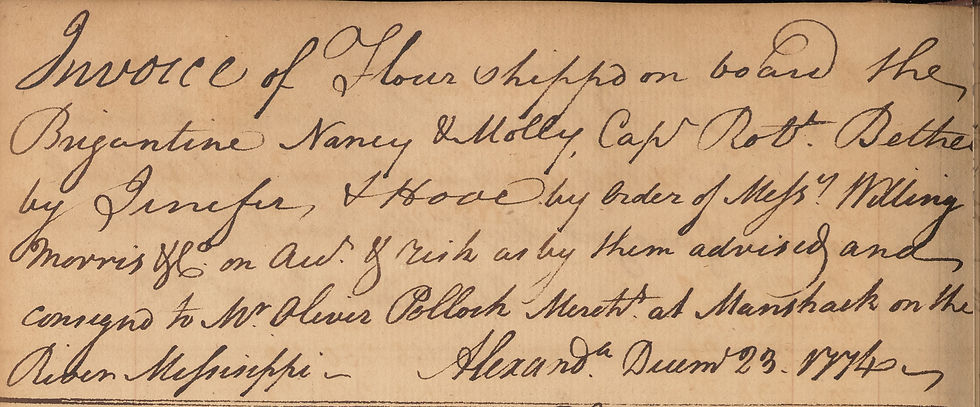Alexandria Flour Went Where?
- History Revealed

- Sep 2, 2021
- 2 min read
Updated: Nov 2, 2023

Here’s an interesting #ThrowBackThursday for Alexandria’s merchant and shipping industry in the 18th century. Looking at Jenifer & Hooe’s invoices for 1774, we discovered a new place name – Manshack on the River Mississippi – which led us down a rabbit hole that will require much more digging to know the rest of the story.
What we know so far: Manshack was also known as Manchac or Fort Bute, in Louisiana. The capture of Fort Bute (1779) during the Revolutionary War marked the entrance of the Spanish to assisting the French and the new United States. But who was the flour’s recipient in Manshack? The 1053 casks of Alexandria-milled flour were sent to Oliver Pollock, an agent of Willing Morris & Co. The Philadelphia firm purchased flour from Jenifer & Hooe (and its predecessor, Hooe, Stone & Co) shipping it out of Alexandria to far flung ports like Barcelona, Bristol, Lisbon, Leghorn, Nice, and Manshack, just to name a few.
An Irish-man by birth, Oliver Pollock emigrated to Pennsylvania in 1759/1760 where he quickly used his Philadelphia connections to take up the merchant trade in Havana, Cuba. He met Cuba’s Governor, General Alejandro O’Reilly; Pollock’s friendship with the governor proved profitable when O’Reilly was sent to the Mississippi Valley to reassert Spain’s control over Louisiana in 1769. Between his relationship with O’Reilly and his reputation as an agent of Willing Morris & Co, Spain granted Pollock free license to trade in the Mississippi Valley and was awarded the flour contract for the garrison in New Orleans (1772). Pollock made his fortunes from the sale of English goods, of flour from Philadelphia (Alexandria), and of enslaved Africans. He went on to become a major financial backer of the American Revolution – going into substantial debt as a result – and is credited with the being first to use the $ symbol in reference to the dollar.
Sometimes a small question leads to a much larger story and shows how 18th-century Alexandria had connections to communities and events far from its small harbor on the Potomac River.
Image credit: Hooe, Stone, & Company Invoice Book, 1770-1784. Courtesy of the New York Public Library.




Comments